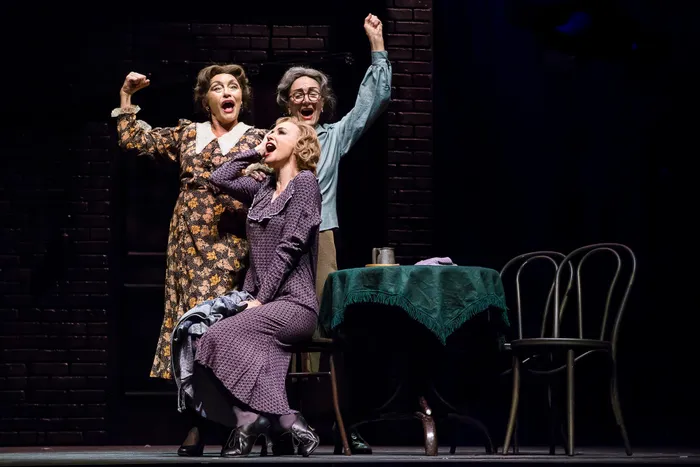Funny Girl: A Broadway legend that will delight all

BELTING OUT A FAVOURITE: Michele Maxwell as Mrs Meeker, Diane Wilson as Mrs Strakosh and Kate Normington as Rose Brice. Picture: Jesse Kramer BELTING OUT A FAVOURITE: Michele Maxwell as Mrs Meeker, Diane Wilson as Mrs Strakosh and Kate Normington as Rose Brice. Picture: Jesse Kramer
FUNNY GIRL – THE MUSICAL
Fugard Theatre
Music: Jule Styne. Lyrics: Bob Merrill. Musical director: Charl-Johan Lingenfelder.
Choreographer: Louisa Talbot. Set: Saul Radomsky. Costumes: Birrie le Roux.
Lighting Design: Daniel Galloway and Benjamin du Plessis. Sound: Mark Malherbe.
The period when Funny Girl – the Jule Styne/Bob Merrill 1963 musical – takes place is shortly before and shortly after World War I. Action is around New York, and Fanny Brice, Broadway star, film actress and comedienne tells her story in flashback.
It takes a special kind of honesty to stand in front of a mirror and accept your looks and figure may not fall into “beauty contest” category, but you still have something to offer showbiz (If a Girl Isn’t Pretty). That’s the sort of honesty teenager Fanny Brice (Ashleigh Harvey) had when deciding her destiny lay in a stage career.
Encouraged by friend Eddie Ryan (Cameron Botha), she set her sights on Vaudeville. Her mother, Mrs Brice (Kate Normington), and Eddie’s duet Who Taught Her Everything, lament if, and when, Fanny’s career starts, she’ll forget them.
Mrs Brice has two card playing friends – Mrs Strakosh (Diane Wilson) and Mrs Meeker (Michele Maxwell). Dispensing sound Jewish advice to Fanny on how to live her life, Normington, Maxwell and Wilson’s wit and gutsy characterisations display their collective theatrical experiences… almost stealing the show.
Fanny’s first job with Mr Florenz Ziegfield’s (Mike Huff) Ziegfield Follies is as a bride in romantic bridal scene. Fronting a white scalloped curtain and flanked by gorgeous leggie dancers in exquisite white lace wedding gowns, Fanny can’t suppress her natural comic side. To His Love Makes Me Beautiful, she wobbles down the aisle as a tipsy, about to give birth, bride. Hilarious! But not quite what Ziegfield, elegant impresario, and producer of extravagant stage revues, expected. However, Ziegfield has the grace to admit Fanny was wonderful and hires her.
Meeting tall, handsome, suave gambler Nick Arnstein (Clyde Berning) changes Fanny’s life. When she takes him to her mother’s opening night party on Henry Street, it’s clear she’s fallen. However, in the famous song People she admits their lifestyles would make life together complicated.
Eventually they do marry. Move into a mansion (Sadie Sadie). Have a child after which her star shines over Broadway again. Self assured, forever optimistic, Nick continues his gambling habits. After unsuccessfully seeking $68 000 to invest in a gambling casino, Fanny (willingly) gives him her savings. Predictably the casino fails. Broke, Nick gets involved in shady deals that land him in prison.
Meanwhile Fanny’s career, backed by beautiful Follies girls in Birrie le Roux’s exotic feathers, plumes, tassels, glitter and glitz costumes, seems unstoppable (Rat-Tat-Tat-Tat).
When Nick returns, she asks him Who Are You Now? He decides they must separate. Courage is what Fanny drew upon to launch her career. Alone in a spotlight, courage is what she once more draws on as she reprises Don’t Rain on my Parade and Funny Girl ends.
Like Fanny, Harvey doesn’t physically fit into the classic beauty brigade. but she has an arresting personality, an ability to move, sing and act in a manner that advances Fanny’s story, character and the period. Between Harvey and Berning ran a dynamic partnership with their final scene a bit of a tear jerker.
Botha is a competent singer and dancer whose percussive footwork clearly sounded out every one of choreographer Louisa Talbot’s rhythmic combinations. As did Sven Eric Muller in his tap shoes. Muller’s scene as Prince Siegfried in Talbot’s Swan Lake left much to be desired if looked at from a classical ballet puritan’s point of view. Under Funny Girl circumstances he was a hoot. So too Harvey’s tutu clad Odette supported by arm flapping sur les pointe corps de ballet swans.
Director Matthew Wild’s creative mind goes from strength to strength. A cast numbering 18 moving and dancing on such a small stage takes skill if they aren’t to look squashed or cramped.
Assisted by the cast acting as set designer Saul Radomsky’s “furniture/prop removers” and a revolving stage swinging in other bits and pieces, Wild’s direction at no time allowed that problem to creep in. Neither did the energetic cast, in spite of umpteen numbers and fast costume changes.
Funny Girl’s music and songs are not as sing-along as perhaps those in the Sound of Music or Annie, but Styne’s music to Merrill’s lyrics is pleasant on the ear. Top marks to Charl-Johan Lingenfelder leading his nine-piece band so comfortably through their paces. A gold medal to sound designer Mark Malherbe for keeping decibels from ear-drum rupturing levels. Daniel Galloway and Benjamin du Plessis’s lighting plot created subtle variable atmospheres.
Musicals based on real-life characters always make interesting theatre. When combined with star-quality performers, the show becomes a must-see. Funny Girl is from Tuesdays to Fridays at 8pm. Saturdays at 4pm and 8pm. Tickets R130-R350.
Book at www.computicket.com 0861 915 8000 or 021 461 4554.